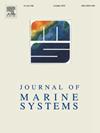Evaluation and projection of Arctic sea ice transport through Fram Strait with emphasis on atmospheric multimodal responses
IF 2.5
3区 地球科学
Q2 GEOSCIENCES, MULTIDISCIPLINARY
引用次数: 0
Abstract
This study evaluates the historical (1988–2014) sea ice drift (SID), sea ice concentration (SIC), sea ice thickness (SIT), and associated sea ice volume transport (SIVT) from 12 CMIP6 models in Fram Strait based on multi-source reference datasets. In addition, a global ice-ocean coupled model based on the Finite Volume Community Ocean Model (Global-FVCOM), is included as a comparison. Both the simulated and reference SIVT show significant interannual variability, but inter-model spread exists. Compared to reference data, the CMIP6 models exhibit greater discrepancies than Global-FVCOM. The comprehensive assessment reveals notable performance differences among the models in simulating varying sea ice variables. Ensemble experiments, incorporating models with varying performance in simulating SIVT, demonstrate a decreasing trend in SIVT across all schemes under the SSP2–4.5 and SSP5–8.5 scenarios, with a more pronounced decline in the latter. Compared to the traditional multi-model mean scheme using all models, the scheme selecting six better-performing models through evaluation results of SIVT exhibits lower SIVT values and a slower decline. There are significant differences among the CMIP6 models regarding the dominant factors contributing to future SIVT variations. The largest number of models demonstrates a strong relationship between the dipole anomaly (DA) and sea ice transport, followed by those associated with the Arctic Oscillation (AO), while the fewest models show a significant connection to the Beaufort-Barents Oscillation (BBO). The choice of time period, whether by year or month, considerably influences the identification of dominant modes for sea ice transport.
北极海冰通过弗拉姆海峡运输的评估和预测,重点是大气多模式响应
基于多源参考数据,利用12个CMIP6模式,对福里姆海峡地区1988-2014年的海冰漂移(SID)、海冰浓度(SIC)、海冰厚度(SIT)和相关海冰体积输运(SIVT)进行了评估。此外,还采用了基于有限体积群落海洋模型(global - fvcom)的全球冰海耦合模型作为对比。模拟和参考SIVT均表现出显著的年际变化,但模式间存在差异。与参考数据相比,CMIP6模型比Global-FVCOM模型表现出更大的差异。综合评价表明,不同模式在模拟不同海冰变量方面存在显著差异。综上实验表明,在SSP2-4.5和SSP5-8.5情景下,所有方案的SIVT均呈下降趋势,其中SSP2-4.5和SSP5-8.5情景下SIVT下降更为明显。与使用所有模型的传统多模型均值方案相比,通过SIVT评价结果选择6个表现较好的模型的方案SIVT值更低,下降速度更慢。在影响未来SIVT变化的主要因素方面,CMIP6模式之间存在显著差异。最大数量的模式显示了偶极子异常(DA)和海冰运输之间的强烈关系,其次是与北极涛动(AO)相关的模式,而最少的模式显示了与波弗特-巴伦支涛动(BBO)的显著联系。时间段的选择,无论是按年还是按月,对海冰运输的主要模式的确定有很大的影响。
本文章由计算机程序翻译,如有差异,请以英文原文为准。
求助全文
约1分钟内获得全文
求助全文
来源期刊

Journal of Marine Systems
地学-地球科学综合
CiteScore
6.20
自引率
3.60%
发文量
81
审稿时长
6 months
期刊介绍:
The Journal of Marine Systems provides a medium for interdisciplinary exchange between physical, chemical and biological oceanographers and marine geologists. The journal welcomes original research papers and review articles. Preference will be given to interdisciplinary approaches to marine systems.
 求助内容:
求助内容: 应助结果提醒方式:
应助结果提醒方式:


